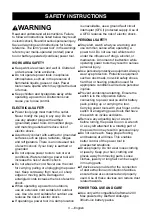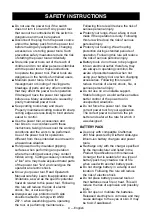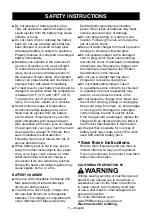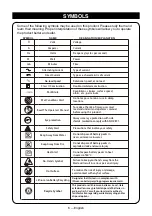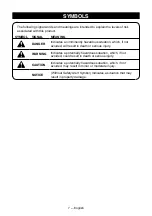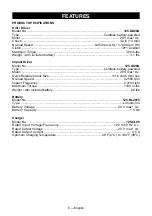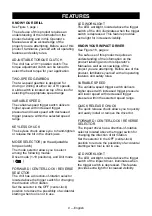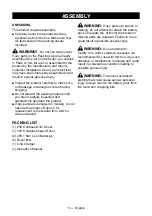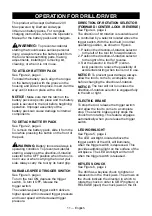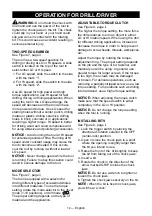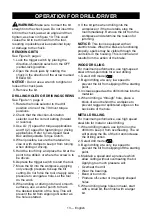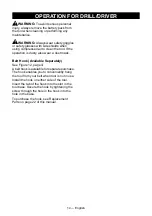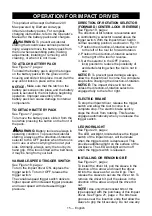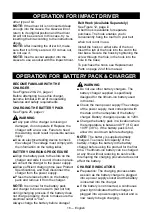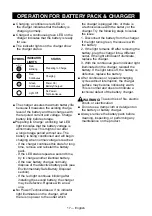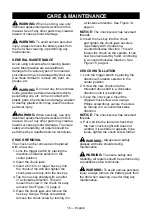
4 ― English
■ Do not use the power tool if the switch
does not turn it on and off. Any power tool
that cannot be controlled with the switch is
dangerous and must be repaired.
■ Disconnect the plug from the power source
and/or the battery pack from the power tool
before making any adjustments, changing
accessories, or storing power tools. Such
preventive safety measures reduce the risk
of starting the power tool accidentally.
■ Store idle power tools out of the reach of
children and do not allow persons unfamiliar
with the power tool or these instructions
to operate the power tool. Power tools are
dangerous in the hands of untrained users.
■ Maintain power tools. Check for
misalignment or binding of moving parts,
breakage of parts and any other condition
that may affect the power tool’s operation.
If damaged, have the power tool repaired
before use. Many accidents are caused by
poorly maintained power tools.
■ Keep cutting tools sharp and clean.
Properly maintained cutting tools with sharp
cutting edges are less likely to bind and are
easier to control.
■ Use the power tool, accessories and
tool bits etc. in accordance with these
instructions, taking into account the working
conditions and the work to be performed.
Use of the power tool for operations
different from those intended could result in
a hazardous situation.
■ Hold power tool by insulated gripping
surfaces when performing an operation
where the cutting accessory may contact
hidden wiring. Cutting accessory contacting
a "live" wire may make exposed metal parts
of the power tool "live" and could give the
operator an electric shock.
■ Know your power tool. Read Operator's
Manual carefully. Learn its applications and
limitations, as well as the specific potential
hazards related to this power tool. Following
this rule will reduce the risk of electric
shock, fire, or serious injury.
■ Always wear eye protection with side
shields marked to comply with ANSI
Z87.1 when assembling parts, operating
the tool, or performing maintenance.
Following this rule will reduce the risk of
serious personal injury.
■ Protect your lungs. Wear a face or dust
mask if the operation is dusty. Following
this rule will reduce the risk of serious
personal injury.
■ Protect your hearing. Wear hearing
protection during extended periods of
operation. Following this rule will reduce
the risk of serious personal injury.
■ Battery tools do not have to be plugged
into an electrical outlet; therefore, they
are always in operating condition. Be
aware of possible hazards when not
using your battery tool or when changing
accessories. Following this rule will
reduce the risk of electric shock, fire, or
serious personal injury.
■ Do not use on an unstable support.
Stable footing on a solid surface enables
better control of the power tool in
unexpected situations.
■ Do not force the power tool. Use the
correct power tool for your application.
The correct power tool will do the job
better and safer at the rate for which it
was designed.
BATTERY PACK
■ Use only with compatible Craftsman
20V Max powered by DieHard slide-type
lithium-ion battery chargers and power
tools.
■ Recharge only with the charger specified
by the manufacturer and listed in the
Product Specifications in this manual.
A charger that is suitable for one type of
battery pack may create a risk of fire
when used with another battery pack.
■ Do not charge battery in a damp or wet
location. Following this rule will reduce
the risk of electric shock.
■ Do not place battery powered tools or
their batteries near fire or heat. This will
reduce the risk of explosion and possibly
injury.
■ Do not open or mutilate the batteries.
Released electrolyte is corrosive and may
cause damage to the eyes or skin. It may
be toxic if swallowed.
SAFETY INSTRUCTIONS



